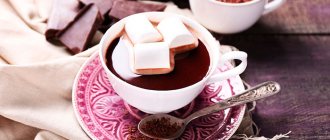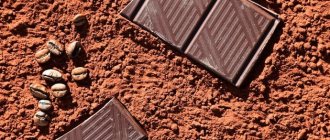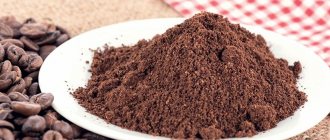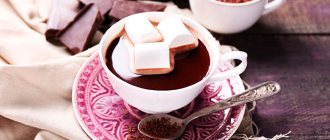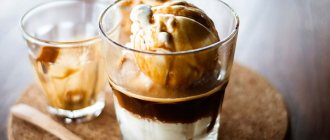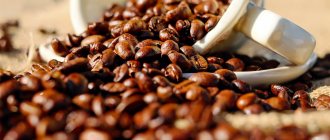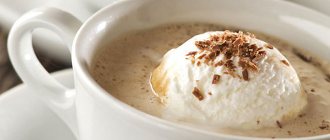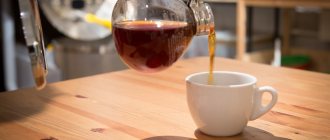Many people start their morning with coffee. It charges with vigor, activity and enchants with its aroma. And the variety of ways to prepare this drink makes it universal for all people. For lovers of sweets, tender, rich and aromatic Viennese style, or the well-known and beloved “Raf” is suitable. For those who prefer a sharper taste, a strong and rich “Espresso” or aromatic Turkish style is suitable. Another unique feature of coffee is the ability to supplement it with various additives. One option is marshmallows.
Preparation
Prepare all the necessary ingredients for making marshmallows.
They are very simple and simple. We also prepare in advance the forms in which we will make marshmallows. These could be: shaped silicone molds for candies, large silicone molds for baking biscuits, or just regular silicone mats. It all depends on what we want to get out of it. If the marshmallow is shaped, then we use shaped shapes; if it’s just cubes, then we use a regular round baking dish. If there are no silicone molds, then you can take ordinary metal ones and put cling film in them. Lubricate the entire inner surface of the molds with a thin layer of tasteless and odorless vegetable oil. This is necessary so that the finished marshmallow comes out of the mold easily and does not stick. There is no need to worry about the taste; oil does not affect the taste of the finished product in any way.
Soak gelatin (30 g) with cold water (100 ml) in a small bowl. I used instant gelatin powder so I didn't think about soaking time. If you have gelatin that needs a long soak, then take care of this step in advance. In any case, you should follow the information on the packaging.
Now let's make sugar syrup. It's not difficult at all and doesn't take long. Pour water (100 ml) and invert syrup (150 g) into a small saucepan, add sugar (400 g) and, if desired, vanillin or vanilla sugar.
Place the pan on the stove and bring the mixture to a boil. In this case, it is better to stir the syrup with a spoon all the time so that the sugar dissolves faster. We need to bring the temperature of the boiling syrup to 115°C; at approximately this temperature we obtain the concentration of sugar syrup we need. If you don’t have a cooking thermometer, it doesn’t matter - just boil the syrup for 2-3 minutes. Remove the pan from the stove.
Heat the previously soaked gelatin in the microwave or in a water bath until it completely dissolves in water. The main thing is not to overheat above 60-70°C; gelatin will lose its gelling properties. Therefore, if you heat it in the microwave, then heat it for 5 seconds, stir, check the temperature and degree of solubility, and heat again until the gelatin dissolves in water. Pour the resulting mass through a sieve into a mixing bowl.
Start beating with a mixer and immediately pour in the hot syrup in a medium stream.
Beat with a mixer at maximum speed for 5-7 minutes. The time depends on the capabilities of the device. While beating, the mixture will increase in volume and turn white. As soon as the mass begins to stick strongly to the beaters, you should stop whipping.
Next, pour the mixture into the previously prepared molds (they are greased with vegetable oil). In this photo, I pour it into a regular mold and get a hefty piece of marshmallow, which I then cut into small cubes. By the way, after pouring the mixture into the mold, you can gently tap the mold on the table to release excess air bubbles.
Part of the mass can be transferred to a pastry bag and filled into shaped molds, also prepared earlier and greased with vegetable oil.
Place the molds in the refrigerator for at least 3-4 hours (overnight is possible) out of sight. During this time, the mass will stabilize, strengthen and set.
After the specified time, we prepare all the necessary items for further work: 2 bowls, a knife and a sieve. In a large bowl, mix cornstarch and powdered sugar in a 1 to 1 ratio.
We simply squeeze the marshmallow, which we poured into shaped silicone molds, into the starch/powder mixture and shake it in a bowl so that the entire surface of the marshmallow is covered and it stops being sticky. Then we take out the pieces, put them in a sieve and shake the sieve so that the excess powder falls off. Transfer the finished marshmallows to a separate bowl.
Now let's take on our big piece. Generously sprinkle the board and work surface with the starch/powder mixture. Dump a piece of marshmallow onto the board. Sprinkle it with powder. Next, we need to cut it into the pieces that we want to get. For example, I cut it into small cubes so that I could serve it to guests and throw it into hot cocoa. Lightly sprinkle the knife with powder and work with it skillfully and confidently, without unnecessary fuss. Correct movements from top to bottom, and not forward to back, as usually happens when cutting bread.
Marshmallow is ready! It should be stored in a tightly closed bag or container without access to air, otherwise it will gradually begin to crust and dry out. Bon appetit!
Delicious homemade blackcurrant marshmallows
Homemade marshmallows will never compare to store-bought ones. It is much softer and has a more natural taste. This is especially noticeable if the delicacy is made from berries. In this case, we are preparing a sweet with black currants - it gives a beautiful deep color and rich berry aroma. These marshmallows can be a great gift for friends and colleagues for the holidays - you just need to find beautiful boxes.
Cooking time: 55 min.
Cooking time: 35 min.
Servings: 6.
Ingredients:
- Black currant – 700 gr.
- Agar-agar – 8 gr.
- Water – 150 ml.
- Granulated sugar – 600 gr.
- Egg white – 1 pc.
- Powdered sugar – 100 rub.
- Corn starch – 50 gr.
Cooking process:
- We sort out the blackcurrant berries from foreign debris, wash and dry them. Using an immersion blender, puree the currants, then rub the resulting mass through a fine sieve. Place the pureed homogeneous puree in a saucepan and boil at low temperature for seven to ten minutes with stirring. After this, remove the saucepan from the stove and pour 200 grams into the puree. granulated sugar from the total amount. Stir until the sugar crystals dissolve and leave to cool to room temperature.
- Place agar-agar and water in the specified amount in a separate saucepan. Stir and heat on the stove until boiling. As soon as the mixture boils, add the remaining granulated sugar.
- Stir the sugar into the liquid mixture and heat it on the stove at the same time. As soon as the mixture boils again, stop stirring.
- Cook the mixture at medium-high temperature until it reaches 110 degrees. It is convenient to use a food thermometer at this stage. If there is no such device, then we focus on time - it will take one and a half to two minutes. The mass will actively foam.
- By the time the syrup boils, you need to start whipping the berry puree with the egg whites. Place these ingredients in a bowl and beat them with a mixer at high speed. The mixture will begin to lighten and increase in volume.
- By the time the temperature of the syrup reaches 110 degrees, the protein-currant mass should already be fluffy and noticeably lighter.
- Pour the hot syrup into the whipped mixture in a thin stream, without stopping the mixer. The syrup should be poured into the mass without touching the wall of the bowl and whisk with the stream, so that there is no premature solidification of the agar-agar. After the syrup is completely introduced, continue beating for another five to seven minutes. The mass will noticeably increase in volume.
- The final mass is very thick, airy and homogeneous. It slowly flows down from the rim in a heavy layer.
- Place the still warm mixture into a pastry bag with a star tip and place the marshmallows on parchment paper or a silicone mat.
- We leave the planted marshmallows for a day at room temperature so that they dry well, stabilize, become elastic and resistant to pressure. Sift powdered sugar and starch into a wide bowl. Roll dried marshmallows in this mixture. You can glue them together in pairs before doing this. Shake off excess sprinkles.
- The finished marshmallow has an airy, soufflé-like texture. It is very tender and fragrant. We recommend storing the treat in a tightly closed cardboard box.
Bon appetit!
What can be replaced
To talk about substitutes, you must first understand the difference between traditional marshmallows and marshmallows. The fact is that the latter is a chewing marshmallow or marshmallow (a more familiar name for Russia). There are other differences: marshmallows, unlike marshmallows, do not contain egg yolk or applesauce. However, it takes longer to melt and remain on the surface of the coffee.
If we are talking about preparing mastic for a cake, then you cannot replace marshmallows. Only this marshmallow has the necessary ductility and dense texture. However, if we talk about coffee, then you can find a replacement.
If you want to add marshmallows to your coffee, but the stores are closed, there are two options to solve the problem. The first is “marshmallow braids”, which are sold in supermarkets. Second, marshmallows can be made from traditional marshmallows. To do this, the product must be melted in the microwave until it can be stirred. This happens slowly, you need to be patient. For this recipe you need white marshmallows in the amount of 500 g and powdered sugar (900 g).
Melt marshmallows in a water bath. To do this, add a little distilled water to the product, place the bowl with the mass in another container with water and heat it in the microwave for 30 seconds. If the product has not melted during this time, it is necessary to repeat the procedure until the desired result is obtained.
Powdered sugar is added to the finished viscous mass and the substance is kneaded like dough. The result is a material from which you can make a flat cake and cut it into cubes. You can also roll balls and cut out flowers and figures from a thin cake.
At the kneading stage, you can add liquid vanilla extract, any other components and even dyes. Vanilla will give the product a pleasant aroma that will go well with the taste of coffee.
Marshmallow with coffee is a dessert for adults, but you can also pamper a child with it, especially if you are preparing a children's party. It is enough to brew regular cocoa from powder diluted in water and hot milk. Pour cocoa into tall mugs and place 5-6 marshmallows on the surface. Be sure to serve along with teaspoons so that the children themselves can help the lozenges melt, which will add a little more playful aspect to the program.
Marshmallow is an almost universal dessert. It can be eaten in its usual form, fried on a skewer, melted to make plastic mastic, added to coffee, cocoa, and hot chocolate. Chewing marshmallows can be prepared at home, then you will always have a healthy dessert at hand.
Story
Marshmallow plant ( Marshmallow officinalis
)
The word "marshmallow" comes from a species of mallow plant ( Marshmallow
), a plant native to parts of Europe, North Africa and Asia that grows in swamps and other wet places. The stem and leaves of the plant are fleshy, and the white flower has five petals. Exactly when marshmallows were invented is unknown, but its history dates back to 2000 BC. It is said that the ancient Egyptians were the first to prepare them, and eating them was a privilege strictly reserved for the gods and royalty, who used the plant's root to relieve coughs and sore throats, as well as to treat wounds. The first marshmallows were prepared by boiling pieces of root pulp with honey until thickened. After thickening, the mixture was filtered, cooled and then used for its intended purpose.[3][4]
Whether used for candy or medicine, marshmallow production was limited. In the early and mid-1800s, marshmallows found their way to France, where confectioners enhanced the plant's traditional medicinal value with ingredients used by the Egyptians. Owners of small candy shops collected the juice from the mallow root into a fluffy candy form. These sweets were called Pâte de Guimauve. It was a spongy-soft dessert made by whipping marshmallow roots with sugar, water and egg white. It was sold in bar form as a flatbread. Drying and preparing the marshmallows took one to two days before the final product could be produced.[5] In the late 1800s, candy makers began looking for a new process and discovered the starch magnet system, in which trays of modified cornstarch had mold pressed firmly into them to create cavities within the starch. The cavities were then filled with the whipped marshmallow juice mixture and allowed to cool or harden.[6] At the same time, candy makers began replacing mallow root with gelatin, creating a stable marshmallow form.[4]
By the early 1900s, thanks to the starch baron system, marshmallows were introduced to the United States and became available for mass consumption. They were sold in tins as penny candies and soon became used in various food recipes such as banana fluff, lime mallow sponge and tutti frutti. In 1956, Alex Dumac patented[7] an extrusion process that involved passing marshmallow ingredients through pipes. The tubes formed a long rope of marshmallow mixture and were then set up to cool. The ingredients are then cut into equal parts and packaged.[4]
Modern marshmallow production has been highly automated since the early 1950s, when the extrusion process was first developed. Numerous improvements and enhancements make it possible to produce thousands of pounds of marshmallows per day.[8] Today, marshmallows typically consist of four ingredients: sugar, water, air, and a whipping agent (usually egg white). The type of sugar and whipping agent varies depending on the desired characteristics. Each ingredient plays a specific role in the final product.
Development of modern marshmallow
Confectioners in early 19th century France pioneered the innovation of beating marshmallow juice and sweetening it to create a confection similar to modern marshmallows. Confectionery products were made locally by the owners of small confectionery shops. They extracted the juice from the mallow root and churned it themselves. The candies were very popular, but their production was labor-intensive. In the late 19th century, French manufacturers thought about using egg whites or gelatin, combined with modified cornstarch, to create a chewy base. This avoided the labor-intensive extraction process, but required industrial methods to properly combine gelatin and cornstarch.[9][10]
Another milestone in marshmallow production was the creation of an extrusion production process by Greek-American confectioner Alex Dumac, of. Doumak Inc., in the late 1940s. In this process, which Dumac patented in 1956,[7] the marshmallow mixture is pumped through extrusion heads with numerous ports aligned next to each other, which form continuous "strands" of marshmallow. This invention allowed marshmallows to be produced in a fully automated manner and gives us the familiar cylindrical shape of modern marshmallows. To make marshmallows in large quantities, industrial confectioners mix water, sugar and corn syrup in huge kettles, which are then heated to a certain temperature and cooked for a certain time. This mixture is then pumped into another kettle for cooling. The rehydrated gelatin is added and stirred in when the mixture is cool enough so that the gelatin does not denature. To make the marshmallow fluffy, it is passed through a blender, pumping air. At this point it still needs to be cooled to keep its shape when extruded, and it is pumped through a heat exchanger before being pumped through the extrusion heads onto a wide conveyor belt. The conveyor belt is coated with cornstarch, and more cornstarch is sprinkled onto the top of the extruded marshmallow as it passes down the conveyor. At the end of this conveyor table is a large knife, equal to the width of the conveyor, which chops the extrusion into marshmallows of the desired size. The pieces will then be mixed with cornstarch in a large drum, allowing the marshmallows to form their usual skin and allowing the pieces that were not cut completely to fall apart.[10]
Marshmallows, like most candies, are sweetened with sucrose. They are produced by aerating mixtures of sucrose and proteins to a final density of about 0.5 g/kg. The molecular structure of marshmallows is simply a solution of sugar mixed with stabilizing structural agents such as gelatin, xanthan gum, or egg whites. The above structural components prevent air from escaping and breaking down the marshmallows during aeration.[11]
Cooking secrets
Not everyone today is ready to claim that they know how to make coffee with marshmallows. Nevertheless, there are many different recipes from which anyone can choose the option they like best. The easiest way involves the following initial ingredients: ground natural coffee, cream, marshmallows and chocolate.
The process technology is extremely simple:
- First you need to brew coffee according to all the rules. It must be strong in order to maximize the taste of additional ingredients.
- Pour the finished drink into a cup.
- Sprinkle some chewy marshmallows on top and mix well. The product will immediately begin to increase in volume, forming a stable foam.
- To make the dessert more appetizing, its surface can be decorated with grated chocolate.
The product turns out to be spectacular and very elegant. And thrill-seekers can use a few additional ingredients for decoration. This will make the drink even tastier.
A confectionery product, marshmallow, based on syrup, sugar, and gelatin, is very popular in North America. Small marshmallows of different shapes and colors are served for dessert, they are used to make decorations for cupcakes, pastries, cakes, and they are used to complement hot drinks. Marshmallows are added to coffee, hot chocolate and cocoa. Marshmallows melt in hot coffee, cover it with an airy “cap”, and fill it with amazing taste and aroma.
Roasted marshmallows
Roasting Marshmallows Marshmallows roasted over an open fire are a popular camping treat.
Open plate of graham crackers, marshmallows and chocolate. A popular camping or gardening tradition in the United Kingdom,[20] North America, New Zealand and Australia is roasting or toasting marshmallows over a fire or other open flame.[21] The marshmallow is placed on the end of a stick or skewer and held carefully over the fire. This creates a caramelized outer shell with liquid, a molten layer underneath. The underlying flavor compounds and color polymers associated with sugar browning are created during the caramelization process.[22]
S'mores are a traditional campfire treat in the United States that are made by placing toasted marshmallows on a slab of chocolate that is sandwiched between two graham crackers. They can then be squeezed and the chocolate will begin to melt.[23]
Marshmallow and its calorie content
Marshmallow is a sweet, chewy dessert created from a combination of sugar, syrup and gelatin. The first recipes for such soft sweets were found in Ancient Egypt, but they gained popularity and distribution throughout the world from French confectioners. Today, an unusual form of serving is coffee with marshmallows.
Marshmallow is a type of marshmallow. This dessert is very popular in the USA, but here it is not very common. Although you can now buy this delicacy in almost any store.
In appearance and texture, marshmallows resemble the well-known marshmallow. However, these are completely different desserts. Let's figure out what marshmallows and marshmallows are, what is the difference between these sweets.
Marshmallow is a sweet made from fruit and berry puree, whipped with egg white and sugar. In order for the mass to acquire a certain texture, gelling agents are added to it. This can be pectin or agar-agar; gelatin is less commonly used. Marshmallows, as a rule, have a round shape.
For the drink, it is better to choose a white dessert as small as possible.
Marshmallows contain sugar, corn syrup and gelatin. The shape of the candies can be cylindrical, spiral or square. They are smaller than classic marshmallows. In the classic version, the candies are produced in white color with a light vanilla aroma. But now other options are being produced - colored marshmallows, glazed candies, with the addition of nuts, poppy seeds, and various toppings.
Marshmallows can't just be served with tea. This delicacy is traditionally roasted over a fire, added to fruit salads, and used to make homemade ice cream or court creams. In addition, you can add marshmallows to aromatic coffee.
Interesting facts: marshmallows were originally made as a cough medicine, since marshmallow syrup was used as a base. This is reflected in the name of the delicacy, since in English this medicinal plant is called “marsh mallow”.
Choosing quality marshmallows is not difficult. Candies should be elastic and viscous. Sweets are packaged in transparent bags or jars, so you can evaluate the appearance of the dessert in the store.
The hot and invigorating drink is prepared according to dozens of recipes, which are based on the classic method of brewing ground coffee, into which marshmallow cubes are placed. It is better to choose marshmallows for the drink in the traditional white color, without painted decorative elements.
Chewing marshmallows can also be made at home. To do this you need:
- 25 g of gelatin is poured with half a glass of cold boiled water, left for 30-40 minutes;
- a glass of sugar, corn syrup and water are combined in a saucepan, a pinch of salt is added and simmered for about 10 minutes until the sugar dissolves and thickens;
- the warm mixture is combined with swollen gelatin and beaten in a blender until fluffy;
- you can add vanillin and beat well again;
- Prepare a shallow baking dish, sprinkle the bottom with powdered sugar, spoon out the whipped mixture, sprinkle with powder again and leave in a cool place for 10-12 hours.
This is how you make homemade chewy marshmallows
After hardening, the mass is cut into cubes, sprinkled with powdered sugar again and placed in an airtight glass container for storage. The marshmallows are ready, now you can make coffee. By the way, 100 grams of dessert is almost 320 kcal!
Recommendations
- Wells, John (3 April 2008). Longman Pronunciation Dictionary
(3rd ed.). Pearson Longman. ISBN 978-1-4058-8118-0. - Petkiewicz, Rachel (2006). “What is this thing? Zephyr." Chemistry and mechanical engineering news
.
84
(16): 41. doi:10.1021/cen-v084n016.p041. Retrieved 2008-02-10. - "How to make marshmallows." www.madehow.com
. Archived from the original 10/31/2016. - ^ a b c
“Zephyr”.
www.candyusa.com
. National Confectioners Association. In the archive from the original dated December 13, 2016. - Pownell, Beaty (1904). Queen Cookbooks
(2nd ed.). London: Horace Cox. - Almond, Steve (01/01/2005). Candyfreak: A Journey Through America's Chocolate Underbelly
. Harcourt. OCLC 56661890. - ^ a b
https://patentimages.storage.googleapis.com/d6/62/cd/0452de37f3e955/US2847311.pdf - ^ a b c d
Hartel, Richard;
Hartel, AnnaKate (2014). Candy: The Science of Sweets
. New York: Copernicus. pp. 199–202. ISBN 978-1-4614-9382-2. - Rohde, Eleanur Sinclair (1936). Herb garden
. Hale Cushman and Flint. - ^ a b
History of marshmallows Archived October 25, 2014 Wayback Machine USA Candy! - Terry Richardson, Gert Andersen, "Confectionery" in Ullmann's Encyclopedia of Industrial Chemistry 2005 Wiley-VCH, Weinheim. Doi:10.1002 / 14356007.a07_411
- ^ a b
Christian, Elizabeth;
Watzlawick, Vicki (1996). Fundamentals of Food Science
. New York, New York: Marcel Dekker. - ^ a b c
Liu, Eunice (2015).
"Homemade marshmallows." scienceandfooducla.wordpress.com
. In the archive from the original dated December 21, 2016. - ^ a b c
Greweling, Peter (2013).
Candy and Confectionery: Formula, Theory and Technique for the Artisan Pastry Chef
. New York: John Wiley and Sons. pp. 296–311. ISBN 978-0-470-42441-4. - Hartel, Richard W.; Ergun, Roya; Vogel, Sarah (01/01/2011). "Phase/state transitions of confectionery sweeteners: thermodynamic and kinetic aspects." Comprehensive Reviews in Food Science and Food Safety
.
10
(1): 17–32. Doi:10.1111/j.1541-4337.2010.00136.x. ISSN 1541-4337. - ^ a b c
Hegenbert, Scott (1995).
"Sweet facts about confectionery making." www.naturalproductinsider.com
. In the archive from the original dated December 20, 2016. - Husband, Tom (October 2014). "The Sweet Science of Candy Making." www.acs.org
. American Chemical Society. Archived from the original on December 22, 2016. - Fennema, Owen (1996). Food chemistry
. New York, New York: Marcel Dekker. ISBN 978-0-8247-9346-3. - "Corn syrup." www.Merriam-Webster.com
. In the archive from the original dated December 20, 2016. - It hurts, Claire. "47. Cooking over a fire." National Trust's South West Blog
. Archived from the original 11/21/2015. Retrieved 2015-11-21. - The Story of Marshmallows by the Campfire Archived 2011-11-03 on the Wayback Machine. campfiremarshmallows.com
- "The Science Behind the Perfectly Toasted Marshmallow." 2017-06-11.
- "The Definition of S'MORE." www.mw.com
. Archived from the original December 18, 2007 - “Products with minimal nutritional value.” www.fns.usda.gov
. Appendix B to 7 CFR Part 210. Food and Nutrition Service, USDA. September 13, 2013. Retrieved 2017-08-04. - "Alternatives to Gelatin." PETA
. Archived from the original on 10/24/2017. Retrieved 2017-10-24. - "A Closer Look - Gelatin is Kosher Alcohol." OK Kosher Certification
(in Japanese). Received 2019-12-31. - "These gelatin-free marshmallow brands will get you ready for vegan eating season." PETA
. Archived from the original on 10/24/2017. Retrieved 2017-10-24.
Figures
To prepare the figures that you can see in the photos of the finished cakes, you will need mastic made from marshmallows. It’s easy to make them from this dough, the main thing is to use your imagination. There are several rules that should be followed so that your confectionery masterpiece is not spoiled by unforeseen circumstances:
- Finished figures should not come into contact with moisture, otherwise the mastic will begin to melt.
- It is best to decorate the cake with ready-made figures before serving, or a couple of hours before.
- You can store figurines for decorating cakes in the freezer as long as you like.
- Only food coloring can be used to color mastic. You can paint ready-made figures.
Marshmallows – we cook it ourselves
For those who believe that store-bought sweets are harmful, as well as for those who like to work magic in the kitchen, there is a marshmallow recipe that you can make yourself. To do this you will need:
- water 150 ml and for adding to marshmallows 250 ml;
- citric acid for adding to syrup – 2/3 tsp;
- powdered sugar – 0.5 cups;
- starch - 0.5 cups;
- gelatin – 20 g;
- soda - on the tip of a knife;
- sugar – 400 g for syrup and 400 g for marshmallows;
- salt on the tip of a knife.
Cooking steps:
- Prepare the syrup. Take a saucepan with a thick bottom, dilute sugar in water. When the water boils, add citric acid. Close the pan and simmer the liquid for 45 minutes over low heat. The syrup should be bright yellow in color.
- After the syrup has cooled slightly, dissolve soda in a dessert spoon and pour the solution into the pan. The resulting foam disappears after a few minutes. This indicates the syrup is ready. Even if the foam remains, remove the pan from the heat. If the syrup is cooked for more than 10 minutes, it turns not white, but beige.
- We take half of the resulting liquid, and pour what is left into a jar, which should be stored at room temperature.
- Pour gelatin into a glass, fill it halfway with water and leave. After this, we begin to heat the gelatin in a water bath until it is completely dissolved. But don't boil! Leave the resulting mass in the pan so that it does not thicken while preparing the syrup.
- Take another pan, mix the other half of the water, syrup, salt and sugar in it. Bring to a boil, continuously stirring the mixture with a spoon. After it boils, stop doing this and boil for 8 minutes.
- Cover the baking dish with foil or cling film and grease with vegetable oil.
- Turn on the mixer at minimum speed and beat the gelatin, gradually pouring in the syrup. We increase the speed and continue to do this until the mass thickens and begins to increase in size. Now you can add dye.
- Pour the mixture into the mold, cover with foil and leave for 6 hours.
- Pour sifted starch mixed with powdered sugar in equal parts onto the table. We spread the mass. Remove the foil and cut into pieces, which are then rolled in starch and powdered sugar.
The treat is ready! The dessert should be stored at room temperature in a sealed container.
Content
- 1 History 1.1 Development of modern marshmallow
- 2.1 Protein 2.1.1 Albumin (egg whites)
- 2.2.1 Sucrose
- 2.3.1 Flavors
- 3.1 Commercial process
Making marshmallows at home
Marshmallows can be made at home, and not just bought in various supermarkets. To do this, take:
- powdered sugar - one hundred and seventy grams;
- gelatin - ten grams;
- honey - two tbsp. spoons;
- corn starch - one tbsp. spoon.
Take four tablespoons of boiling water and pour gelatin over it. Wait twenty minutes for it to swell. Pour powdered sugar into a bowl, pour water into it and put it on the stove to cook. The fire should be low. Cooking will take ten minutes. Don't forget to stir from time to time.
You will need to beat the gelatin with a mixer and pour in a little syrup and beat again. The remaining syrup will need to be added in a thin stream after a minute. After a certain time, the consistency will gradually become white and thick. You will need to continue whisking for another five minutes. The speed should be average.
Take parchment paper and apply a mixture of powdered sugar and starch there. After this, the sausages that you have obtained will need to be cut and rolled in sugar-starch breading. And that’s it, your marshmallows will be ready.
Boiled coffee with marshmallows
Marshmallow is a very common type of dessert in North America and is just beginning to win the hearts of sweet tooths in our country. Do not confuse classic marshmallows, made with applesauce, eggs and gelatin, with this foreign sweet. Marshmallows are made from gelatin, syrup and sugar. These little airy marshmallows taste very much like regular marshmallows; you can even hear the name “chewy marshmallows.”
Step-by-step instruction:
- Place ground coffee beans in a pot, fill it with water and heat over low heat.
- Wait until the liquid begins to boil and rise above the initial level. Remove from heat and let stand for a minute. To brew aromatic, delicious coffee, you cannot boil it!
- Pour the finished coffee into a glass or cup, place marshmallows on top and let them melt a little so that foam appears on the surface.
Watch this video on YouTube
Features of the filler
Marshmallows are small cylindrical-shaped confectionery products (as in the photo), reminiscent of marshmallows in consistency and taste, but differing in composition. If classic marshmallows are made from fruit puree, sugar, egg white and a thickener (usually gelatin), then marshmallows are made from syrup, sugar and gelatin, and food coloring is also added to make the lozenges different colors. The very name of the products comes from the Latin name of the marshmallow plant, the root of which was originally used for their manufacture.
Cup with coffee and marshmallows
This delicacy began to be made in the USA in the middle of the 20th century, at which time devices for its production were patented. The recipe quickly spread throughout the world, and now these “lozenges” are not only eaten in their pure form, but also added to various desserts - cakes, pastries, ice cream, and even fried over a fire to make them more viscous from the inside. Marshmallows are also added to coffee prepared in different ways. You can make many different delicious drinks with these pieces.
Cooking methods
The answer to the question of how to make coffee with marshmallows at home is quite simple. You need to brew the drink in a Turk (preferably from freshly ground grains and using filtered water), pour it into a cup, and just put “marshmallows” on top, stir until they begin to dissolve into foam, then you can drink. This is the most common and simplest recipe, but there are many others. Knowing how to make different versions of this dessert, you can treat yourself to it both on holidays and on any day.
Dessert
Recipe for a milk drink with the addition of marshmallows:
- boil milk (about 150 ml) over low heat;
- add a spoonful of ground coffee there;
- boil the mixture over low heat for 2 minutes;
- pour into a cup, add marshmallows, stir;
- add sugar to taste (you can often do without it, since the added pieces are already sweet enough);
- When the “lozenges” begin to melt, stir again.
How to make a chocolate drink:
- make coffee;
- melt dark chocolate (in a water bath);
- add 50 ml of milk and heat over low heat (1-2 minutes) - the result will be chocolate milk;
- mix it all in one cup, decorate with marshmallows.
Recipe with milk and cream:
- start brewing coffee with sugar, add milk (300 ml);
- remove from heat as soon as foam appears and the drink boils;
- strain and pour into cups;
- decorate with lozenges, and when they melt, with whipped cream.
In any case, you should drink the drink when the filler has at least partially dissolved and foam has formed. The photo shows the stages of preparation.
Dietary preferences
Marshmallow Bunnies in an Easter Basket
The traditional marshmallow recipe uses powdered marshmallow root, but most commercial marshmallows instead use gelatin in their making. Vegans and vegetarians should avoid gelatin, but there are versions that use a non-animal gelling agent substitute such as agar.[25] Additionally, marshmallows are generally not considered kosher or halal unless their gelatin comes from kosher or halal animals or they are vegan.[26]
Marshmallow cream and other less solid marshmallow products typically contain little or no gelatin, which mainly serves to help the familiar marshmallow confectionery maintain its shape. They usually use egg whites instead. Non-gelatin versions of this product containing eggs can be consumed by ovo vegetarians. There are several brands of vegetarian and vegan marshmallows and marshmallow fluff.[27]
